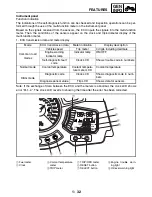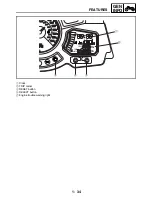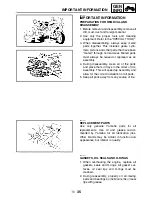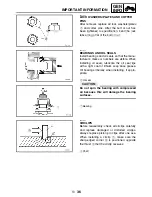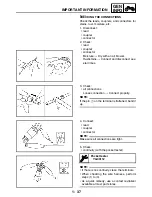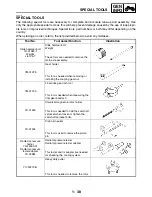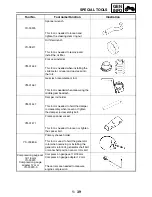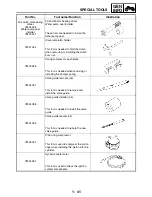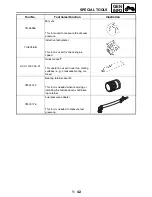
1 - 27
GEN
INFO
FEATURES
Functions of components
Catalyst
Because the conditions in which NOx is generated are directly opposed to those of CO and HC,
there is a limit to the extent to which the concentration levels of these harmful elements can be
reduced in the combustion stage. Hence, the function of the catalyst is to clean the exhaust gas at a
high degree of efficiency by removing CO, HC, and NOx in the exhaust stage.
This model has adopted a monolith type metallic catalyst with a honeycomb construction, which
achieves a low exhaust resistance through the large surface area of the catalyst body (with a high
level of cleaning efficiency).
Catalytic substances consisting of precious metals such as platinum and rhodium are adhered to
the wall surface of these honeycomb cells, which are enclosed in the exhaust pipe. As the exhaust
gas comes in contact with these catalytic substances, the chemical reactions of oxidation and
reduction advance in order to clean the exhaust gas.
• The CO and HC oxidize with the oxidation function of platinum, and are converted into harmless
carbon dioxide (CO
2
) and water (H
2
O), resulting in cleaner exhaust gases.
• The NOx is reduced by the reduction function of rhodium, which converts NOx into harmless nitro-
gen (N
2
) and oxygen (O
2
), resulting in cleaner exhaust gases.
To clean the exhaust gases at a high rate of efficiency through the maximization of these catalytic
capacities, it is necessary to maintain and control the mixture in the vicinity of the stoichiometric air-
fuel ratio of (14.7:1) at all times. As a means of maintaining the stoichiometric ratio, this system has
adopted an O
2
feedback compensation method that uses an O
2
sensor, which will be described in
the next section.
Equipment
Functions
Main components
Three-way catalytic
converter system
Catalyzer (honeycomb
type)
Simultaneously reduces
CO, HC, and NOx emis-
sions.
• Catalytic converter
• Catalyst case
Air-fuel compensation
equipment
Reduces CO, HC, and NOx
emissions. The catalyst pri-
marily cleans the exhaust
gases in order to ensure
the stoichiometric air-fuel
ratio.
• O
2
sensor
• ECU
Fuel cut-off equipment
Reduces CO and HC emis-
sions, improves fuel econ-
omy, and cuts off fuel
during deceleration.
• Throttle position sensor
• ECU
CO + 1/2 O
2
CO
2
HC + O
2
CO
2
+ H
2
O
NOx
N
2
+ O
2
Summary of Contents for FJR1300
Page 1: ...LIT 11616 16 18 5JW 28197 10 FJR1300R FJR1300RC SERVICE MANUAL ...
Page 6: ......
Page 82: ...2 22 SPEC TIGHTENING TORQUES Cylinder head tightening sequence Crankcase tightening sequence ...
Page 89: ...2 29 SPEC 1 Crankshaft 2 Main axle 3 Drive axle OIL FLOW DIAGRAMS ...
Page 90: ...2 30 SPEC 1 Oil nozzle 2 Main gallery bolt 3 Crankshaft OIL FLOW DIAGRAMS ...
Page 91: ...2 31 SPEC 1 Main axle 2 Drive axle 3 Oil delivery pipe OIL FLOW DIAGRAMS ...
Page 92: ...2 32 SPEC 1 Exhaust camshaft 2 Oil check bolt 3 Intake camshaft OIL FLOW DIAGRAMS ...
Page 94: ...2 34 SPEC 1 Crank pin 2 Crankshaft OIL FLOW DIAGRAMS ...
Page 97: ...2 37 SPEC 1 Main axle 2 Drive axle 3 Middle drive shaft OIL FLOW DIAGRAMS ...
Page 98: ...2 38 SPEC COOLING SYSTEM DIAGRAMS 1 Radiator COOLING SYSTEM DIAGRAMS ...
Page 99: ...2 39 SPEC 1 Water jacket joint 2 Oil cooler COOLING SYSTEM DIAGRAMS ...
Page 101: ...2 41 SPEC 1 Coolant reservoir 2 Radiator 3 Water pump COOLING SYSTEM DIAGRAMS ...
Page 107: ...2 47 SPEC CABLE ROUTING 1 Tail brake light lead ...
Page 196: ...3 80 CHK ADJ ADJUSTING THE HEADLIGHT BEAMS ...
Page 288: ...4 92 CHAS 3 Install bearing 1 to the swingarm Installed depth a 4 0 mm 0 16 in SWINGARM ...
Page 531: ...8 35 ELEC LIGHTING SYSTEM ...
Page 570: ......
Page 571: ...YAMAHA MOTOR CO LTD 2500 SHINGAI IWATA SHIZUOKA JAPAN PRINTED IN U S A ...




















